The Fish

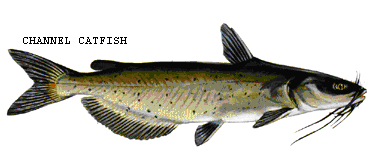

We have compiled a list and description of the most common kinds of fish that we have caught in the Mississippi. Though there are many other varieties, you are sure to nail most of these within one season. Since we fish the Missouri and Illinois banks, the common fish in you're area may vary.
CATFISH
Blue Catfish
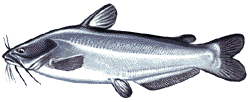
DESCRIPTION: Moderately stout, compressed posteriorly; head and body blue to slate gray above, lighter on sides; belly white. Head small, wedge shaped; eyes small, situated below midline of head; 4 pairs of barbels; mouth small, upper jaw longer than lower. Posterior edge of adipose fin free; outer edge of anal fin straight; 30-36 anal fin rays; caudel deeply forked.
Channel Catfish

DESCRIPTION: Slender; back blue-gray; sides light blue to silvery with scattered dark olive to black spots; belly white; fins olive to dusky. Head wide, flat to straightly rounded above; eye large, above midline of head; upper jaw overhangs lower; 4 pairs of barbels. Adipose fin present; outer edge of anal fin rounded, 24-31 rays; caudal fin deeply forked.
Flathead Catfish
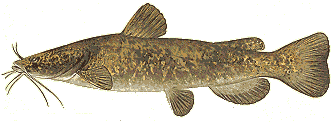
DESCRIPTION: Elongated, slander; back and sides olive-yellow to light brown with dark mottling; belly yellowish; caudal fin dark brown to black, with upper lobe unpigmented; other fins yellowish to light brown. Head large, wide, very flat; eyes small; mouth wide, lower jaw projecting beyond upper, 4 pairs of short barbels. Adipose fin large; dorsal fin spine weak; 14-17 anal fin rays; causal fin truncate, weakly notched.
PERCH-LIKE FISH
White Bass
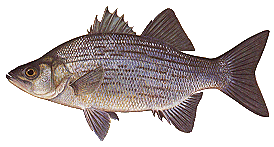
Yellow Bass
DESCRIPTION: Deep, compressed; back olive to silvery-gray; sides silvery to white, with 6-9 dark, narrow stripes, sometimes interrupted below lateral line; belly yellowish. Mouth extends to middle of eye; lower jaw protrudes; single patch of teeth on back of tongue. First dorsal fin separate from second; second anal spine about half length of third, 11-13 soft anal fin rays. 50-60 scales in lateral line; scales extend onto head.
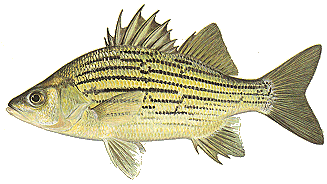
DESCRIPTION: Deep, compressed; back greenish-yellow, sides silvery to brassy yellow with 7-9 dark greenish to black stripes, those below lateral line just anterior to anal fin interrupted and offset; belly yellowish. Mouth extends to eye; lower jaw not protruding; tongue without teeth. Dorsal fins slightly joined at bases; 9-10 soft anal fin rays, second anal spine about same length as third, 49-55 lateral line scales.
Hybrid Bass (White x Striper)
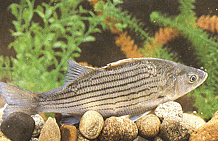 This fish looks like a stockier version of striped bass, usually having a shorter length and greater
girth, but with very similar markings. The main differnce between the stripers and the hybrid are the broken lines along its sides. The lateral lines of the striper are unbroken. Hybrid bass can be identified from white bass by the tooth patterns on their tongues. The white bass has a single broad U pattern while the striper has two distinctive elongated tooth patches.
This fish looks like a stockier version of striped bass, usually having a shorter length and greater
girth, but with very similar markings. The main differnce between the stripers and the hybrid are the broken lines along its sides. The lateral lines of the striper are unbroken. Hybrid bass can be identified from white bass by the tooth patterns on their tongues. The white bass has a single broad U pattern while the striper has two distinctive elongated tooth patches.
Freshwater Drum
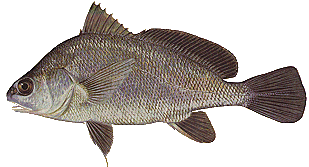
DESCRIPTION: Oblong, robust; greatest depth at dorsal fin origin; silvery-bluish above, sides silvery; whitish below. Mouth ventral. Pelvic fins whitish, median fins dusky. 2 dorsal fins almost completely seperated by deep notch, with scaly sheath at base; 2 anal fin spines, second enlarged, 7 rays; caudal fin moderately pointed. Scales ctenoid; lateral line extends to tip of caudal fin.
SUCKER FISH
Smallmouth Buffalo
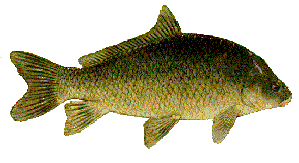
DESCRIPTION: Deep, moderately compressed, back arched, often with ridge anteriorly; dark olive to gray, sides grayish to bronze. Head small; snout bluntly rounded; mouth small, horizontal, ventral, below level of eye; lips thick, plicate. Pelvic fins gray-black, other fins dusky; 24-31 dorsal finrays, anterior rays long, less than ½ length of fin base; 8-9 anal fin rays. Lateral line straight, with 35-39 scales.
Common Carp
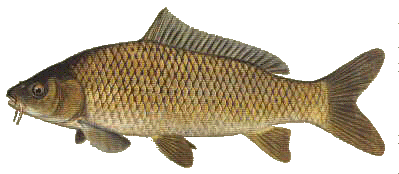
DESCRIPTION: Robust, moderatly compressed; back dark olive, sides lighter, yellowish below; fins dusky-olive. 2 pairs of barbels on upper lip. Dorsal fin long, has 1 stout, serrate spine, 17-21 rays; anal fin with similar spine, 5-6 rays. Lateral line complete, 32-39 scales.
OTHER FISH
Longnose Gar

DESCRIPTION: Cylyndrical; dark olive to brownish above, lighter on sides with dark spots, uaually on posterior, belly whitish. Median fins yellowish-brown with many dark spots; young with mid-dorsal and mid-lateral stripe. Snout very long; more than twice as long as rest of head; teeth large, in 1 row on upper jaw. Caudal fin short, rounded. Scales thick, diamond-shaped, 60-64 in lateral line.
Shovelnose Sturgeon

DESCRIPTION: Elongated, bony plates sharply keeled, olive to yellowish-brown above, sides lighter, white below. Bony head plates with short spines at tip of snout and anterior to eye. Snout shovel-shaped; 4 barbels in straight line; lower lip with 4 papillose lobes; no spiralces. 5 rows of bony plates: 14-19 dorsal plates, 38-47 lateral, 10-14 ventrolateral. Caudel peduncle long, depressed, fully armored; tail heteroceracl, upper lobe with long threadlike filament.
NOTE: This species is VERY similar to the endangered Pallid sturgeon. Pallids have a longer nose and is an ENDANGERED SPECIES. PLEASE return the Pallid unharmed to the river. To avoid confusion we release all sturgeon, so as not to make a mistake.
American Eel
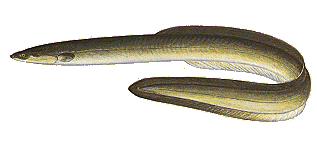
DESCRIPTION: Elongated, snakelike, circular in cross section anteriorly, compressed posteriorly. Color variable depending on habitat and age, usually dark brown or greenish above, fading to yellowish-white on belly. Head large, about 1/8 of length; mouth terminal, nearly horizontal, lower jaw projects slightly. Pectoral fins well developed; dorsal fin origin far behind pectoral fins; anal fin origin behind dorsal fin origin, both fins continuous with caudal fin. Scales small, elliptical, deeply embedded in skin.
BIBLIOGRAPHY: National Audubon Society Field Guide to North American Fishes, Whales, & Dolphins, 1998, Chanticleer Press inc, Alfred A. Knopf inc.

















